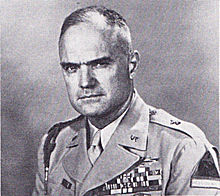Sidney Hinds
Sidney Rae Hinds | |
|---|---|
 | |
| Born | May 14, 1900 Newton, Illinois, US |
| Died | February 17, 1991 (aged 90) San Antonio, Texas, US |
| Allegiance | |
| Service | |
| Years of service | 1920–1947 |
| Rank | |
| Service number | 0-12851 |
| Commands | |
| Battles / wars | World War I World War II |
| Awards | Army Distinguished Service Medal Silver Star (4) Legion of Merit (2) Bronze Star (3) |
Sidney Rae Hinds (May 14, 1900 – February 17, 1991) was an American highly decorated officer of the United States Army with the rank of brigadier general. He was also sport shooter who competed in the 1924 Summer Olympics and won the gold medal in the team rifle competition.[1]
Early life
[edit]
Sidney Rae Hinds was born on May 14, 1900, in Newton, Illinois, as the son of Daniel C. and Elizabeth (Jackson) Hinds. He spent his high school years in Wahpeton, North Dakota, and when he was eighteen years old, he received an appointment from Congressman John Miller Baer to the United States Military Academy at West Point, New York. World War I changed the length of the studies and Hinds graduated in June 1920. He was also commissioned a second lieutenant in infantry.
His class of 1920 was very strong, producing 49 general officers, including Lyman L. Lemnitzer, Clovis E. Byers, Henry I. Hodes, Lawrence J. Carr, Edward J. McGaw, Verne D. Mudge, Richard C. Partridge, Ewart G. Plank, William W. Bessell, Jr., John F. Cassidy, Rex V. Corput, Jr., Francis W. Farrell, William W. Ford, Charles K. Gailey, Joseph E. Harriman, Frederick M. Harris, Sherman V. Hasbrouck, Frederick L. Hayden, Homer W. Kiefer and Maurice W. Daniel.

| Olympic medal record | ||
|---|---|---|
| Representing | ||
| Men's shooting | ||
| 1924 Paris | Team free rifle | |
In 1924 he participated in the Summer Olympics and won the gold medal as a member of the American team in the team free rifle competition.[2] His gold medal in on display at the US Army Infantry Museum at Fort Benning, Georgia.
He died in San Antonio, Texas, on February 15, 1991, and is buried at Fort Sam Houston National Cemetery.
During World War II he saved the German town Ahlen by believing the German Dr. Paul Rosenbaum who was responsible for the hospital town.[clarification needed] In the early 1990s the park in front of the station in Ahlen was named after him.
Medals and decorations
[edit]Here is the ribbon bar of Brigadier general Sidney Rae Hinds:

| |||
References
[edit]- ^ "Sidney Hinds". Sports Reference. Archived from the original on April 18, 2020. Retrieved December 31, 2014.
- ^ "Sidney Hinds". Olympedia. Retrieved November 3, 2021.
- ^ Empric, Bruce E. (2024), Uncommon Allies: U.S. Army Recipients of Soviet Military Decorations in World War II, Teufelsberg Press, p. 88, ISBN 979-8-3444-6807-5
External links
[edit]- 1900 births
- 1991 deaths
- People from Newton, Illinois
- Military personnel from Illinois
- United States Army generals
- United States Military Academy alumni
- United States Army Command and General Staff College alumni
- Recipients of the Distinguished Service Medal (US Army)
- Recipients of the Silver Star
- Recipients of the Legion of Merit
- Knights of the Legion of Honour
- American recipients of the Croix de Guerre 1939–1945 (France)
- American recipients of the Croix de guerre (Belgium)
- American male sport shooters
- ISSF rifle shooters
- Shooters at the 1924 Summer Olympics
- Olympic gold medalists for the United States in shooting
- Olympic medalists in shooting
- Medalists at the 1924 Summer Olympics
- Burials at Fort Sam Houston National Cemetery
- United States Army generals of World War II
- 20th-century American sportsmen
